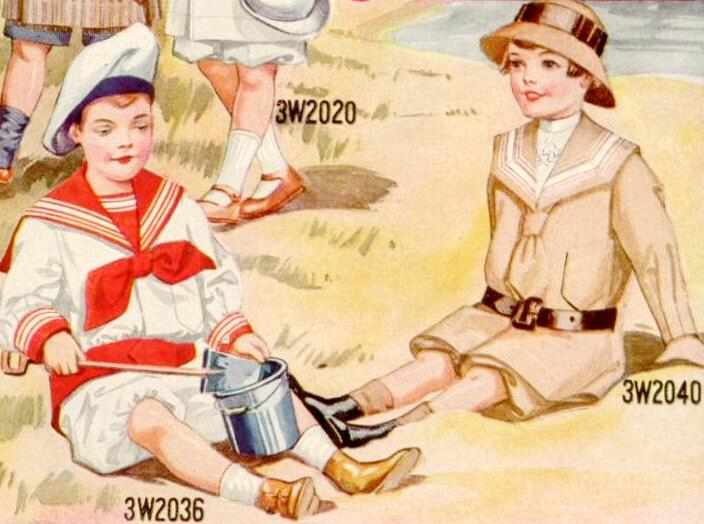
Wards's Russian Blouse Suits, 1914

Figure 1.-- Here we see two little boy outfits offered by Wards in their Summer 1914 catalog. The outfit on the left is a French blouse suit. The outfit on the right is one of several Russian blouses offered. These outfits are shown as play suits. Others were done in fancier styles. Both were done in sizes 2 1/2 to 7 years.
|
Here we see some of the tunic suits offered by Wards in its Summer 1914. Wards called them "Russian blouses" which was a common term at the time. The illustration shows them as a boy's outfit. We have seen girls wearing similar outfits, but here boys tunics are depicted. The suggestion was that this was a play outfit, but some of the styules shown are clearly dressy suits. Some of the outfits had short pants/kneepants while others had bloomer (elasticised) knickers. It is difficult to tell for some of the suits. We refer to these as tunnic suits because the tunic jacket and pants match or were coordinated.
Although the word "consumerism" has a modern ring, it was personal concern for an early consumer movement, the "National Grange of the Patrons of Husbandry," That inspired a young traveling salesman named Aaron Montgomery Ward to start the world's first general merchandise mail-order company in 1872. Aaron Montgomery Ward was born on February 17, 1844, in Chatham, New Jersey, to a family whose forebears had served as officers in the French and Indian Wars as well as in the American Revolution. Looking for something more compatible, Monty left home and followed the river to Lake Michigan and the town of St. Joseph, county seat and market for outlying fruit orchards. Chicago was the center of the wholesale dry goods trade and in the 1860s Ward joined the leading dry goods house, Field Palmer & Leiter. As a retailer, Potter Palmer had previously built a reputation for fair dealing. Ward absorbed these principles while working as a clerk for $5. The Chicago City Directories for 1868 through 1870 listed Ward as a salesman for Wills, Greg & Co. and later for Stetthauers & Wineman, both dry goods houses. In 1870, after canvassing territory in Illinois, Iowa, Missouri, Ward was again footloose. The plan shaping in Ward's mind was to buy goods at low cost for cash. By eliminating intermediaries, with their markups and commissions, and cutting selling costs to the bone, he could offer goods to people, however remote, at appealing prices - for cash. Since its founding in 1872, the company has literally "grown up with America" and has had a major impact on the shopping habits of a nation of consumers. Montgomery Ward & Co. discontinued its catalog operations in 1985 as part of its restructuring effort to change itself into a modern, competitive chain of value-driven specialty stores, a move which for a time saved the company. week
Terminology
Here we see some of the tunic suits offered by Wards in 1914. Wards called them "Russian blouses" which was a common term at the time. Some of the outfits had short pants/kneepants while others had bloomer (elasticised) knickers. It is difficult to tell for some of the suits.
Conventions
The illustration shows them as a boy's outfit. We have seen girls wearing similar outfits, but here boys tunics are depicted. The suggestion was that this was a play outfit, but some of the styules shown are clearly dressy suits.
Garments
These tunic or Russian blouse suits consisted of a tunic jacket which commonly buttoned at the side and pants. The pants were mostly bloomer knickers (knee-length pants with elasticised leg closings), but some were short pants/kneepants. We refer to these outfits as Russian blouse/tunic suits because the tunic jacket and pants match or were coordinated.
Wards offered quite a few different styles of these Russian blouses in its Summer 1914 catalog. Sone were qyuite plain while others were done wiyh fancy detailing. Most hah athe traditional sailor "V" front while one has the plain square oprn boc collar. Almost all of these outfits had some element of sailor styling. Blue and white were the principal colors, but we see one white suit detailed in red. Brown was used which may have been a play outfit. There were other sailor outfits offered, such as suits with middy blouses. The Russian blouse style, however, seems to have been more popular for the younger boys. They were made in sizes for boys 2 1/2 to 7 years.
Other Garments Illustrated
Several other garments are shown in the illustrations. The garments are clearly summer styles.
Headwear
Hosiery
Long stockings were still very common for children in 1914. Note that the younger boys here in summer outfits are all pictured wearing short socks. We have noted photographic portraits showing boys wearing these outfits with long stockings. Also the slightly older boys on this page shown wearing sailor rather than Russian blouses are shown wearing long stockings. The convention suggested by this is short socks leaving the knees bare were only appropriate for younger boys.
Footwear
HBC

Navigate the Boys' Historical Clothing catalog/magazine pages:
[Return to the Main American mail order 1914 page]
[Return to the Main American mail order 1910s page]
[Main photo/publishing page]
[Store catalogs]
[Fashion magazines]
Navigate the Boys' Historical Clothing Web Site:
[Introduction]
[Activities]
[Biographies]
[Chronology]
[Cloth and textiles]
[Clothing styles]
[Countries]
[Topics]
[Bibliographies]
[Contributions]
[FAQs]
[Glossaries]
[Satellite sites]
[Tools]
Navigate the Boys' Historical Clothing Web Site:
[Sailor hats]
[Flat caps]
[Buster Brown suits]
[Sailor suits]
[Eton suits]
[Rompers]
[Tunics]
[Smocks]
[Pinafores]
[Kneepants]
[Knickers]
[Underwear]
Created: 7:35 AM 2/17/2005
Last updated: 12:47 AM 2/20/2005



